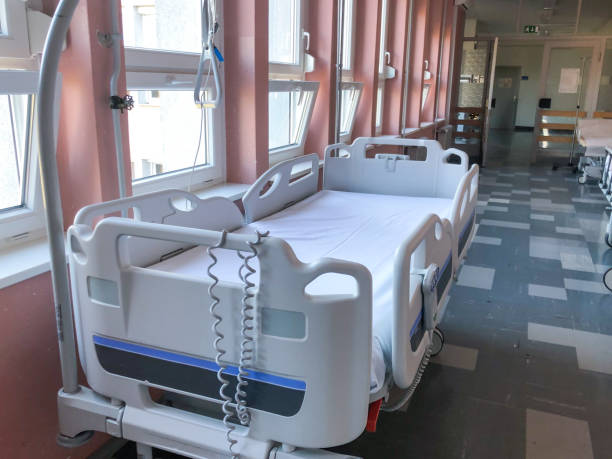Introduction

For individuals with Parkinson's disease, selecting the appropriate bed size can significantly affect their health and overall well-being. It's a crucial decision that requires careful consideration. As this neurodegenerative disorder progresses, it brings about many challenges, including movement, balance, and overall physical comfort.
Considering that individuals with Parkinson's often spend extended periods in bed due to fatigue, mobility limitations, or sleep disturbances, finding the right bed size becomes essential for optimizing comfort, safety, and accessibility. In this blog post, we will explore the factors to consider when choosing a bed size tailored to the unique needs of Parkinson's patients, ensuring they can rest and sleep soundly, promoting better health, and enhancing their overall quality of life.
What is Parkinson's disease?
Parkinson's disease (PD) causes problems with movement, muscle control, and balance. This disease happens when specific cells in the brain are harmed or die, causing a decrease in dopamine levels in the brain. As symptoms progress from mild to more severe over time, it can cause physical deformities, mobility issues, and difficulty with daily tasks.
How Can Bed Size Help Parkinson's Patients?
Larger bed sizes can benefit individuals with Parkinson's by increasing their comfort while sleeping, facilitating easier entry and exit from the bed, and minimizing the risk of accidents. A king-sized mattress is recommended for people with Parkinson's disease as it provides more space to move around with greater freedom and makes getting in and out of bed easier. Using this can decrease the chances of falling and improve their comfort while completing their nighttime routine.
In addition, a king-sized bed may provide more room for a partner to sleep in or for the patient to stretch out comfortably. An adjustable base may also be useful as it allows them to adjust the head and foot of the bed to their preferred position. This can help improve their sleep quality and reduce pain and stiffness from sleeping in an uncomfortable position.
Finally, a king-sized bed may provide more space for assistive devices such as ramps or grab bars. Using this could help the patient move around in bed more safely, reducing the risk of falls. It can also provide support and stability to help reduce the risk of falls.
Overall, a king-sized mattress can benefit people with Parkinson's disease. This size increases the free space for movement, lowers the chances of falling, and simplifies entering and exiting the bed. This is especially true when friction-reducing, mobility-enhancing sheets and sleepwear are used in combination with the adjutable bed. Adjustability features can also be beneficial as they can improve sleep quality and reduce pain and stiffness. Finally, it provides more space for assistive devices to help make the patient's night-time routine safer and easier.
What are the key factors when choosing the right bed size for Parkinson's patients?
When selecting the appropriate bed size for Parkinson's patients, there are 10 essential factors to consider.
Comfort:
The most important factor when selecting a bed for a Parkinson's patient is comfort and ease of mobility. Friction-reducing sheets and sleepwear improve freedom of movement – the resulting reduced effort and struggle to reposition contributes to improved comfort and the ability to relax. Because moving is made much easier, there is greater likelihood of more frequent moving. This helps reduce pain and stiffness that can result from staying in one position for too long. Ensure the mattress and pillows are comfortable and supportive to help reduce the risk of aches or pains caused by sleeping in an uncomfortable position. Look for high-density foam, memory foam layers, or latex contouring mattresses that can help with pressure relief. Also, consider pillows made of natural materials like down and wool which are adjustable to support any sleeping position.
Customizable Options:
It's important to look for a bed that offers adjustable features such as head and footboards, side rails, and even adjustable beds that can be moved to support different sleeping positions. Look for a bed with customizable options and adjustability features to ensure the bed can meet the needs of Parkinson's patients as their condition progresses.
Safety:
Ensure the mattress has been designed with safety in mind, such as being fire-resistant or having anti-slip materials to prevent slipping or sliding if the patient gets up at night. Also, look for beds with built-in safety features such as side rails that can help provide extra support and stability while getting in and out of bed.
Durability:
Look for a durable mattress made from memory foam, latex, or natural elements like wool and cotton. The materials are designed to be durable and enhance comfort for those with Parkinson's who may be spending extended periods in bed due to their condition.
Mobility:
Patients with Parkinson's may need assistance getting into and out of bed, so choosing a bed and bed-related textiles that offer easy mobility is important. Consider friction-reducing sheets and sleepwear that enhance mobility in bed making every move easier.
Support:
Look for a mattress with good support, such as innerspring or memory foam layers. These materials provide additional support, which can help reduce the risk of aches and pains commonly experienced by Parkinson's patients.
Pressure Relief:
Memory foam mattresses distribute a person's weight evenly, which may alleviate discomfort in areas prone to pressure points – however, be certain to evaluate ease of mobility as some people may find memory foam more difficult to move on because of the body weight that sinks into it. If memory foam is still the top choice, using friction-reducing sheets and sleepwear with this type of matttress will still make moving easier. Take advantage of trial periods to see what works best for you.
Ventilation:
Ensure the mattress offers good ventilation, which is important for keeping cool and comfortable throughout the night. Look for mattresses with breathable materials that allow air to circulate, such as wool or latex, or look for beds with a ventilated design.
Cost:
When shopping for mattresses for Parkinson's patients, it's crucial to consider the costs since they can be quite high. Look for deals or promotions that may help you save money, and compare prices to find the best value.
Warranty:
Finally, look for a mattress with a warranty covering any defects or damages during use. Please follow this guidance to ensure your products are of good quality and your investment is safe.
By considering each of these key factors, you can find the right bed size for your Parkinson's patient that is comfortable and supportive. With the right combination of features, comfort, and safety, you can feel confident that you have chosen the optimal bed and conditions for a person with Parkinson’s. These factors will contribute to a better and more comfortable sleep.
Are there any safety concerns related to bed size for Parkinson's patients?

Yes, safety is a major concern for Parkinson's patients regarding bed size. Bed size can affect the ease of mobility and the risk of falls and other injuries. Maneuvering in a bed that is too big can be difficult and may require additional assistance for tasks such as changing positions or getting up. For this reason, selecting a bed size that allows the patient to move adequately and safely is important.
In addition, beds that are too soft may make it more difficult for Parkinson's patients to maintain balance and increase their risk of falls. Therefore, firm mattresses provide better support and improved stability for those with movement disorders such as Parkinson's. A doctor or caregiver should be consulted to determine the right bed size and mattress firmness for individual patients. Bed rails may also be of benefit for additional support and safety.
When choosing a bed size and designing a bedroom, it is crucial to keep the patient's requirements in mind to ensure proper safety and mobility. If the patient cannot move around in their bed, or if they are at risk for falls due to sleeping on an unsuitable mattress, then it is important to consider a different size or type of bed. Additionally, choose mobility-enhancing bed sheets and sleepwear which can optimize the situation.
What are the benefits of choosing an adjustable bed for Parkinson's patients?

Adjustable beds can provide a variety of benefits for Parkinson's patients. These products are created with adjustable features that can aid in alleviating muscle tension and spasms, enhancing sleep posture and circulation, and minimizing the possibility of bed sores or wounds caused by inactivity. Adjustable beds also help promote better respiratory function by allowing patients to move and breathe more easily.
An adjustable bed can help with several challenges posed by Parkinson's disease, including difficulty turning in, problems getting in and out of bed independently, and nighttime restlessness or thrashing. An adjustable bed can help increase your comfort level when you need to remain in one position for a long time.
Adjustable beds also offer great convenience for caretakers, as they can be set to the desired position quickly and easily without manually adjusting the bedding each time. The adjustable bed's motorized adjustments make accommodating any patient's needs or preferences easy throughout the day and night.
FAQ's
What is the best bed for someone with Parkinson's disease?
The best bed for someone with Parkinson's disease depends on their needs and preferences. Generally, adjustable beds offer good support, have breathable materials, and provide pressure relief can benefit those with Parkinson's. It is also important to consider the bed's size and its safety features.
What is the best furniture for Parkinson's patients?
The best furniture for Parkinson's patients should be lightweight and easy to move around, with adjustable features that accommodate their changing needs. Adjustable beds and recliners are especially beneficial for those with Parkinson's as they allow the patient to modify their position throughout the day. Mobility aids such as walkers, wheelchairs, or assistive devices like friction-reducing sheets and sleepwear, and grab bars can provide improved mobility, support and stability.
What is the measurement tool for Parkinson's disease?
The most commonly used measurement tool for Parkinson's disease is the Unified Parkinson's Disease Rating Scale (UPDRS). The scale assesses motor function, including speech, coordination, and balance, using a set of questions and activities. The language used in the output: English. It also assesses non-motor functions such as mental status, mood, behavior, and activities of daily living.
What are the best tools for people with Parkinson's?
The best tools for people with Parkinson's will depend on their needs and abilities. Mobility aids such as walkers, wheelchairs, or assistive devices like friction-reducing sheets and sleepwear, and grab bars can be beneficial for providing support and stability. Adjustable beds and recliners can also help to reduce muscle tension and spasms, improve sleep posture and circulation, and reduce the risk of bed sores or other wounds due to inactivity. Other helpful tools may include voice-activated technology, a stability ball, and pillows for extra support.
What is the gold standard for diagnosing Parkinson's?
The gold standard for diagnosing Parkinson's disease is a combination of clinical assessment and imaging tests, such as MRI or CT scans. Clinical assessment involves examining the patient's symptoms, medical history, and family history. Imaging tests can then detect any abnormalities in the brain associated with Parkinson's disease. In some cases, dopamine transporter scans may also be used to confirm the diagnosis. More recently, researchers have identified a biomarker for Parkinson’s that can improve the accuracy and efficiency of a Parkinson’s diagnosis. This new investigational research tool can detect the “Parkinson’s protein” and identify Parkinson’s with 93% accuracy. This discovery will surely transform Parkinson’s care including earlier diagnosis and targeted treatments.
Conclusion
I hope the article has given enough details to help individuals with Parkinson's choose the appropriate bed size and furniture. Remember, selecting the right bed size and mattress is essential for safety and comfort. To enhance the patient's well-being, we should also consider utilizing additional tools like adjustable beds, mobility aids, voice-activated technology, stability balls, and pillows. Consulting a healthcare provider is crucial in determining the most suitable treatment plan for an individual's needs.

